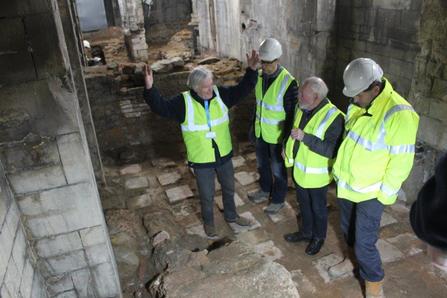 Professor Cunliffe and Cotswold Archaeology's Peter Davenport discussing a Roman dry sweat room (the Laconicum) Professor Cunliffe and Cotswold Archaeology's Peter Davenport discussing a Roman dry sweat room (the Laconicum) Earlier this year I had the great privilege to meet one of the greatest archaeologists of the modern era, Professor Sir Barry Cunliffe, during my work with Cotswold Archaeology, who were working with Bath and Counties Archaeological Society (BACAS) and The Roman Baths Museum on the Archway Project. The project aims to create a new Learning Centre and a World Heritage Centre by revealing parts of the bathing complex that were hitherto inaccessible by the public. The area, which currently lies immediately to the south of the area open to the public (specifically the Kings Bath and Circular Bath) was originally excavated by the Victorians, who created a warren of cellars in the spaces below York Street and Swallow Street. The Roman archaeology, which includes a dry sweat room (Laconicum), plunge pools and a possible running track or exercise area in the southern part of the bathing complex, was exposed and noted at the time, but not recorded to modern standards. Since then a number of small archaeological excavations have been carried out, the most notable by Professor Sir Cunliffe from 1963 onwards. Cotswold Archaeology were commissioned by the Roman Baths Museum to work with volunteers from BACAS to make the first comprehensive record of all of the structures and archaeological deposits within the space. The working included re-opening some of the earlier archaeological trenches, and removing some intrusive modern deposits, to check the accuracy of some of the earlier records and to answer a number of questions regarding the layout and use of this part of the baths. Laser scanning and 3D photography (photogrammetry) techniques were also used to make highly accurate 3D models of the space as it was found in 2018. I was lucky enough to be managing the project for Cotswold Archaeology, and during the course of the work invited Professor Sir Cunliffe back to the site to discuss the context of his earlier work, and his thoughts on the new discoveries we had made, including a fragment of a previously unseen mosaic adjacent to one of the early plunge pools, and a series of compact sand layers that may represent evidence for a covered running track or exercise area. The Roman Baths Museum followed the progress of the work keenly, and commissioned a film crew to record Professor Cunliffe’s visit for posterity. Here’s what happened when we talked to him: https://youtu.be/vBOArQ_lRSg The Roman Baths Museum also commissioned a series of educational films documenting the archaeological process, which will be used in the new Learning Centre. |
AuthorSimon Cox is Director of Bristol & Bath Heritage Consultancy Ltd, and has been an archaeology and heritage specialist for over 27 years CategoriesArchives |
